Mountain

Amountainis an elevated portion of theEarth's crust,generally with steep sides that show significant exposedbedrock.Although definitions vary, a mountain may differ from aplateauin having a limitedsummitarea, and is usually higher than ahill,typically rising at least 300metres(980ft) above the surrounding land. A few mountains areisolated summits,but most occur inmountain ranges.[1]
Mountains are formedthroughtectonic forces,erosion,orvolcanism,[1]which act on time scales of up to tens of millions of years.[2]Once mountain building ceases, mountains are slowly leveled through the action ofweathering,throughslumpingand other forms ofmass wasting,as well as through erosion byriversandglaciers.[3]
High elevations on mountains producecolder climatesthan atsea levelat similar latitude. These colder climates strongly affect theecosystemsof mountains: different elevations have different plants and animals. Because of the less hospitable terrain and climate, mountains tend to be used less for agriculture and more for resource extraction, such asminingandlogging,along with recreation, such asmountain climbingandskiing.
The highest mountain on Earth isMount Everestin theHimalayasofAsia,whose summit is 8,850 m (29,035 ft) above mean sea level. Thehighest known mountainon any planet in the Solar System isOlympus Monson Mars at 21,171 m (69,459 ft).
Definition

There is no universally accepted definition of a mountain. Elevation, volume, relief, steepness, spacing and continuity have been used as criteria for defining a mountain.[5]In theOxford English Dictionarya mountain is defined as "a natural elevation of the earth surface rising more or less abruptly from the surrounding level and attaining an altitude which, relatively to the adjacent elevation, is impressive or notable."[5]
Whether a landform is called a mountain may depend on local usage. John Whittow'sDictionary of Physical Geography[6]states "Some authorities regard eminences above 600 metres (1,969 ft) as mountains, those below being referred to as hills."
In the United Kingdom and the Republic of Ireland, a mountain is usually defined as any summit at least 2,000 feet (610 m) high,[7][8][9][10][11]which accords with the official UK government's definition that a mountain, for the purposes of access, is a summit of 2,000 feet (610 m) or higher.[12]In addition, some definitions also include atopographical prominencerequirement, such as that the mountain rises 300 metres (984 ft) above the surrounding terrain.[1]At one time theUS Board on Geographic Namesdefined a mountain as being 1,000 feet (305 m) or taller,[13]but has abandoned the definition since the 1970s. Any similar landform lower than this height was considered a hill. However, today, theUS Geological Surveyconcludes that these terms do not have technical definitions in the US.[14]
TheUN Environmental Programme's definition of "mountainous environment" includes any of the following:[15]: 74
- Class 1: Elevation greater than 4,500 m (14,764 ft).
- Class 2: Elevation between 3,500 and 4,500 m (11,483 and 14,764 ft).
- Class 3: Elevation between 2,500 and 3,500 m (8,202 and 11,483 ft).
- Class 4: Elevation between 1,500 and 2,500 m (4,921 and 8,202 ft), with a slope greater than 2 degrees.
- Class 5: Elevation between 1,000 and 1,500 m (3,281 and 4,921 ft), with a slope greater than 5 degrees and/or 300 m (984 ft) elevation range within 7 km (4.3 mi).
- Class 6: Elevation between 300 and 1,000 m (984 and 3,281 ft), with a 300 m (984 ft) elevation range within 7 km (4.3 mi).
- Class 7: Isolated inner basins and plateaus less than 25 km2(9.7 sq mi) in area that are completely surrounded by Class 1 to 6 mountains, but do not themselves meet criteria for Class 1 to 6 mountains.
Using these definitions, mountains cover 33% of Eurasia, 19% of South America, 24% of North America, and 14% of Africa.[15]: 14 As a whole, 24% of the Earth's land mass is mountainous.[16]
Geology
There are three main types of mountains:volcanic,fold,andblock.[17]All three types are formed fromplate tectonics:when portions of the Earth's crust move, crumple, and dive. Compressional forces,isostaticupliftand intrusion ofigneous matterforces surface rock upward, creating a landform higher than the surrounding features. The height of the feature makes it either a hill or, if higher and steeper, a mountain. Major mountains tend to occur in long linear arcs, indicating tectonic plate boundaries and activity.
Volcanoes

Volcanoes are formed whena plate is pushed below another plate,or at amid-ocean ridgeorhotspot.[18]At a depth of around 100 km (60 mi), melting occurs in rock above the slab (due to the addition of water), and formsmagmathat reaches the surface. When the magma reaches the surface, it often builds a volcanic mountain, such as ashield volcanoor astratovolcano.[5]: 194 Examples of volcanoes includeMount Fujiin Japan andMount Pinatuboin the Philippines. The magma does not have to reach the surface in order to create a mountain: magma that solidifies below ground can still formdome mountains,such asNavajo Mountainin the US.[19]
Fold mountains

Fold mountains occur when two plates collide: shortening occurs along thrust faults and the crust is overthickened.[20]Since the less densecontinental crust"floats" on the densermantlerocks beneath, the weight of any crustal material forced upward to form hills,plateausor mountains must bebalanced by the buoyancy forceof a much greater volume forced downward into the mantle. Thus the continental crust is normally much thicker under mountains, compared to lower lying areas.[21]Rock canfoldeither symmetrically or asymmetrically. The upfolds areanticlinesand the downfolds aresynclines:in asymmetric folding there may also be recumbent and overturned folds. TheBalkan Mountains[22]and theJura Mountains[23]are examples of fold mountains.
Block mountains
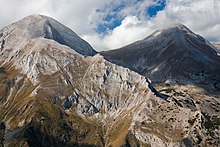
Block mountains are caused byfaultsin the crust: a plane where rocks have moved past each other. When rocks on one side of a fault rise relative to the other, it can form a mountain.[24]The uplifted blocks are block mountains orhorsts.The intervening dropped blocks are termedgraben:these can be small or form extensiverift valleysystems. This form oflandscapecan be seen inEast Africa,[25]theVosgesandRhinevalley,[26]and theBasin and Range Provinceof Western North America.[27]These areas often occur when the regional stress is extensional and thecrustis thinned.[27]
Erosion
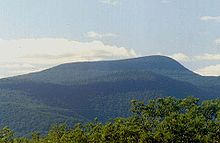
During and following uplift, mountains are subjected to the agents oferosion(water, wind, ice, and gravity) which gradually wear the uplifted area down. Erosion causes the surface of mountains to be younger than the rocks that form the mountains themselves.[28]: 160 Glacial processesproduce characteristic landforms, such aspyramidal peaks,knife-edgearêtes,and bowl-shapedcirquesthat can contain lakes.[29]Plateaumountains, such as theCatskills,are formed from the erosion of an uplifted plateau.[30]
Climate

Climate in the mountains becomes colder at highelevations,due to an interaction betweenradiationand convection. Sunlight in thevisible spectrumhits the ground and heats it. The ground then heats the air at the surface. If radiation were the only way to transfer heat from the ground to space, thegreenhouse effectof gases in the atmosphere would keep the ground at roughly 333 K (60 °C; 140 °F), and the temperature would decay exponentially with height.[31]
However, when air is hot, it tends to expand, which lowers its density. Thus, hot air tends to rise and transfer heat upward. This is the process ofconvection.Convection comes to equilibrium when a parcel of air at a given altitude has the same density as its surroundings. Air is a poor conductor of heat, so a parcel of air will rise and fall without exchanging heat. This is known as anadiabatic process,which has a characteristic pressure-temperature dependence. As the pressure gets lower, the temperature decreases. The rate of decrease of temperature with elevation is known as theadiabatic lapse rate,which is approximately 9.8 °C per kilometre (or 5.4 °F (3.0 °C) per 1000 feet) of altitude.[31]
The presence of water in the atmosphere complicates the process of convection. Water vapor contains latentheat of vaporization.As air rises and cools, it eventually becomessaturatedand cannot hold its quantity of water vapor. The water vapor condenses (formingclouds), and releases heat, which changes the lapse rate from thedry adiabatic lapse rateto themoist adiabatic lapse rate(5.5 °C per kilometre or 3 °F (1.7 °C) per 1000 feet)[32] The actual lapse rate can vary by altitude and by location. Therefore, moving up 100 m (330 ft) on a mountain is roughly equivalent to moving 80 kilometres (45 miles or 0.75° oflatitude) towards the nearest pole.[15]: 15 This relationship is only approximate, however, since local factors such as proximity to oceans (such as the Arctic Ocean) can drastically modify the climate.[33]As the altitude increases, the main form ofprecipitationbecomessnowand the winds increase.[15]: 12
The effect of the climate on the ecology at an elevation can be largely captured through a combination of amount of precipitation, and thebiotemperature,as described byLeslie Holdridgein 1947.[34]Biotemperature is the mean temperature; all temperatures below 0 °C (32 °F) are considered to be 0 °C. When the temperature is below 0 °C, plants aredormant,so the exact temperature is unimportant. The peaks of mountains with permanent snow can have a biotemperature below 1.5 °C (34.7 °F).
Climate change
Mountain environments are particularly sensitive to anthropogenic climate change and are currently undergoing alterations unprecedented in last 10,000 years.[35] The effect of global warming on mountain regions (relative to lowlands) is still an active area of study. Observational studies show that highlands are warming faster than nearby lowlands, but when compared globally, the effect disappears.[36]Precipitation in highland areas is not increasing as quickly as in lowland areas.[36] Climate simulationsgive mixed signals about whether a particular highland area will have increased or decreased precipitation.[37]
Climate change has started to affect the physical and ecological systems of mountains. In recent decades mountain ice caps and glaciers have experienced accelerating ice loss.[38]The melting of the glaciers, permafrost and snow has caused underlying surfaces to become increasingly unstable. Landslip hazards have increased in both number and magnitude due to climate change.[39]Patterns of river discharge will also be significantly affected by climate change, which in turn will have significant impacts on communities that rely on water fed from alpine sources. Nearly half of mountain areas provide essential or supportive water resources for mainly urban populations,[40]in particular during the dry season and in semiarid areas such as in central Asia.
Alpine ecosystems can be particularly climatically sensitive. Many mid-latitude mountains act as cold climate refugia, with the ecosystems occupying small environmental niches. As well as the direct influence that the change in climate can have on an ecosystem, there is also the indirect one on the soils from changes in stability and soil development.[41]
Ecology

The colder climate on mountains affects the plants and animals residing on mountains. A particular set of plants and animals tend to be adapted to a relatively narrow range of climate. Thus, ecosystems tend to lie along elevation bands of roughly constant climate. This is calledaltitudinal zonation.[42] In regions with dry climates, the tendency of mountains to have higher precipitation as well as lower temperatures also provides for varying conditions, which enhances zonation.[15][43]
Some plants and animals found in altitudinal zones tend to become isolated since the conditions above and below a particular zone will be inhospitable and thus constrain their movements ordispersal.These isolated ecological systems are known assky islands.[44]
Altitudinal zones tend to follow a typical pattern. At the highest elevations, trees cannot grow, and whatever life may be present will be of thealpinetype, resemblingtundra.[43]Just below thetree line,one may findsubalpineforests ofneedleleaftrees, which can withstand cold, dry conditions.[45]Below that,montane forestsgrow. In the temperate portions of the earth, those forests tend to be needleleaf trees, while in the tropics, they can bebroadleaf treesgrowing in arain forest.
Mountains and humans
The highest known permanently tolerable altitude is at 5,950 metres (19,520 ft).[46]At very high altitudes, the decreasing atmospheric pressure means that less oxygen is available for breathing, and there is less protection against solar radiation (UV).[15]Above 8,000 metres (26,000 ft) elevation, there is not enough oxygen to support human life. This is sometimes referred to as the "death zone".[47]The summits ofMount EverestandK2are in the death zone.
Mountain societies and economies
Mountains are generally less preferable forhumanhabitation than lowlands, because of harsh weather and little level ground suitable foragriculture.While 7% of the land area of Earth is above 2,500 metres (8,200 ft),[15]: 14 only 140 million people live above that altitude[48]and only 20-30 million people above 3,000 metres (9,800 ft) elevation.[49]About half of mountain dwellers live in theAndes,Central Asia, and Africa.[16]
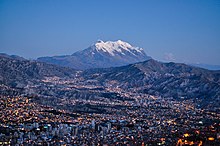
With limited access to infrastructure, only a handful of human communities exist above 4,000 metres (13,000 ft) of elevation. Many are small and have heavily specialized economies, often relying on industries such as agriculture, mining, and tourism.[50]An example of such a specialized town isLa Rinconada, Peru,a gold-mining town and the highest elevation human habitation at 5,100 metres (16,700 ft).[51]A counterexample isEl Alto,Bolivia,at 4,150 metres (13,620 ft), which has a highly diverse service and manufacturing economy and a population of nearly 1 million.[52]
Traditional mountain societies rely on agriculture, with higher risk ofcrop failurethan at lower elevations. Minerals often occur in mountains, withminingbeing an important component of the economics of some montane societies. More recently,tourismsupports mountain communities, with some intensive development around attractions such asnational parksorski resorts.[15]: 17 About 80% ofmountain peoplelive below the poverty line.[16]
Most of the world'sriversare fed from mountain sources, with snow acting as a storage mechanism for downstream users.[15]: 22 More than half of humanity depends on mountains for water.[53][54]
Ingeopoliticsmountains are often seen as preferable "natural boundaries"between polities.[55][56]
Mountaineering
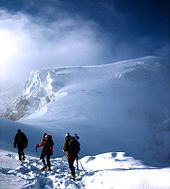
Mountain climbing, or alpinism is thesport,hobbyorprofessionof hiking, skiing, and climbing mountains. While mountaineering began as attempts to reach the highest point of unclimbed big mountains it has branched into specializations that address different aspects of the mountain and consists of three areas: rock-craft, snow-craft and skiing, depending on whether the route chosen is overrock,snoworice.All require experience, athletic ability, and technical knowledge of the terrain to maintain safety.[57]
Mountains as sacred places
Mountains often play a significant role inreligion.There are for example a number of sacred mountains withinGreecesuch asMount Olympuswhich was held to be thehome of the gods.[58]In Japanese culture, the 3,776.24 m (12,389.2 ft) volcano ofMount Fujiis also held to be sacred with tens of thousands of Japanese ascending it each year.[59]Mount Kailash,in theTibet Autonomous Regionof China, is considered to be sacred in four religions:Hinduism,Bon,Buddhism,andJainism.InIreland,pilgrimagesare made up the 952 metres (3,123 ft)Mount BrandonbyIrish Catholics.[60]TheHimalayanpeak ofNanda Deviis associated with theHindugoddesses Nanda and Sunanda;[61]it has been off-limits to climbers since 1983.Mount Araratis a sacred mountain, as it is believed to be the landing place ofNoah's Ark.In Europe and especially in theAlps,summit crossesare often erected on the tops of prominent mountains.[62]
Superlatives
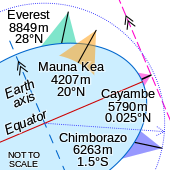
Heights of mountains are typically measuredabove sea level.Using this metric,Mount Everestis the highest mountain on Earth, at 8,848 metres (29,029 ft).[63]There are at least 100 mountains with heights of over 7,200 metres (23,622 ft) above sea level, all of which are located in central and southern Asia. The highest mountains above sea level are generally not the highest above the surrounding terrain. There is no precise definition of surrounding base, butDenali,[64]Mount KilimanjaroandNanga Parbatare possible candidates for the tallest mountain on land by this measure. The bases of mountain islands are below sea level, and given this considerationMauna Kea(4,207 m (13,802 ft) above sea level) is the world's tallest mountain andvolcano,rising about 10,203 m (33,474 ft) from thePacific Oceanfloor.[65]
The highest mountains are not generally the most voluminous.Mauna Loa(4,169 m or 13,678 ft) is the largest mountain on Earth in terms of base area (about 2,000 sq mi or 5,200 km2) and volume (about 18,000 cu mi or 75,000 km3).[66]Mount Kilimanjarois the largest non-shield volcano in terms of both base area (245 sq mi or 635 km2) and volume (1,150 cu mi or 4,793 km3).Mount Loganis the largest non-volcanic mountain in base area (120 sq mi or 311 km2).
The highest mountains above sea level are also not those with peaks farthest from the centre of the Earth, because thefigure of the Earthis not spherical. Sea level closer to the equator is several miles farther from the centre of the Earth. The summit ofChimborazo,Ecuador's tallest mountain, is usually considered to be the farthest point from the Earth's centre, although the southern summit ofPeru's tallest mountain,Huascarán,is another contender.[67]Both have elevations above sea level more than 2 kilometres (6,600 ft) less than that of Everest.
See also
- List of mountain ranges
- List of peaks by prominence
- List of ski areas and resorts
- Lists of mountains
- Mountain hut– Building in the mountains with food and shelter
- Seven Summits
References
- ^abcJackson, Julia A., ed. (1997). "Mountain".Glossary of Geology(4th ed.).Alexandria, Virginia:American Geological Institute.ISBN0922152349.
- ^Levin, Harold L. (2010).The Earth Through Time(9th ed.).Hoboken, New Jersey:Wiley.p. 83.ISBN978-0470387740.
- ^Cooke, Ronald U.; Cooke, Ronald Urwick; Warren, Andrew (1 January 1973).Geomorphology in Deserts.University of California Press.ISBN978-0-520-02280-5.
- ^"The 'Highest' Spot on Earth".Npr.org. 7 April 2007.Archivedfrom the original on 30 January 2013.Retrieved31 July2012.
- ^abcGerrard, A.J. (1990).Mountain Environments: An Examination of the Physical Geography of Mountains.Cambridge, Massachusetts: MIT Press.ISBN978-0-262-07128-4.
- ^Whittow, John (1984).Dictionary of Physical Geography.London: Penguin. p. 352.ISBN0-14-051094-X.
- ^Nuttall, John & Anne (2008).England.The Mountains of England & Wales. Vol. 2 (3rd ed.). Milnthorpe, Cumbria: Cicerone.ISBN978-1-85284-037-2.
- ^"Survey turns hill into a mountain".BBC News.Archivedfrom the original on 2 October 2013.Retrieved3 February2013.
- ^"A Mountain is a Mountain – isn't it?".www.go4awalk.com.Archivedfrom the original on 8 February 2013.Retrieved3 February2013.
- ^"mountain".dictionary.reference.com.Archivedfrom the original on 5 February 2013.Retrieved3 February2013.
- ^Wilson, Peter (2001)."Listing the Irish hills and mountains"(PDF).Irish Geography.34(1). Coleraine: University of Ulster: 89.doi:10.1080/00750770109555778.Archived fromthe original(PDF)on 10 May 2013.
- ^"What is a" Mountain "? Mynydd Graig Goch and all that..."Metric Views.Archived fromthe originalon 30 March 2013.Retrieved3 February2013.
- ^"What is the difference between" mountain "," hill ", and" peak ";" lake "and" pond "; or" river "and" creek? "".US Geological Survey.
- ^"What is the difference between lake and pond; mountain and hill; or river and creek?".USGS.Archivedfrom the original on 9 May 2013.Retrieved11 February2013.
- ^abcdefghiBlyth, S.; Groombridge, B.; Lysenko, I.; Miles, L.; Newton, A. (2002)."Mountain Watch"(PDF).UNEP World Conservation Monitoring Centre, Cambridge, UK. Archived fromthe original(PDF)on 11 May 2008.Retrieved17 February2009.
- ^abcPanos (2002)."High Stakes"(PDF).Archived(PDF)from the original on 3 June 2012.Retrieved17 February2009.
- ^"Chapter 6: Mountain building".Science matters: earth and beyond; module 4.Pearson South Africa. 2002. p. 75.ISBN0-7986-6059-7.
- ^Butz, Stephen D (2004)."Chapter 8: Plate tectonics".Science of Earth Systems.Thompson/Delmar Learning. p.136.ISBN0-7668-3391-7.
- ^Fillmore, Robert (2010).Geological evolution of the Colorado Plateau of eastern Utah and western Colorado, including the San Juan River, Natural Bridges, Canyonlands, Arches, and the Book Cliffs.Salt Lake City: University of Utah Press. p. 430.ISBN978-1607810049.
- ^Searle, Michael P (2007)."Diagnostic features and processes in the construction and evolution of Oman-, Zagros-, Himalayan-, Karakoram-, and Tibetan type orogenic belts".InRobert D. Hatcher Jr.;MP Carlson; JH McBride; JR Martinez Catalán (eds.).4-D framework of continental crust.Geological Society of America. pp. 41 ff.ISBN978-0-8137-1200-0.
- ^Press, Frank; Siever, Raymond (1985).Earth(4th ed.). W.H. Freeman. p.413.ISBN978-0-7167-1743-0.
- ^Hsü, Kenneth J.; Nachev, Ivan K.; Vuchev, Vassil T. (July 1977). "Geologic evolution of Bulgaria in light of plate tectonics".Tectonophysics.40(3–4): 245–256.Bibcode:1977Tectp..40..245H.doi:10.1016/0040-1951(77)90068-3.
- ^Becker, Arnfried (June 2000). "The Jura Mountains — an active foreland fold-and-thrust belt?".Tectonophysics.321(4): 381–406.Bibcode:2000Tectp.321..381B.doi:10.1016/S0040-1951(00)00089-5.
- ^Ryan, Scott (2006)."Figure 13-1".CliffsQuickReview Earth Science.Wiley.ISBN0-471-78937-2.
- ^Chorowicz, Jean (October 2005). "The East African rift system".Journal of African Earth Sciences.43(1–3): 379–410.Bibcode:2005JAfES..43..379C.doi:10.1016/j.jafrearsci.2005.07.019.
- ^Ziegler, P.A.; Dèzes, P. (July 2007). "Cenozoic uplift of Variscan Massifs in the Alpine foreland: Timing and controlling mechanisms".Global and Planetary Change.58(1–4): 237–269.Bibcode:2007GPC....58..237Z.doi:10.1016/j.gloplacha.2006.12.004.
- ^abLevin 2010,pp. 474–478.
- ^Fraknoi, A.; Morrison, D.; Wolff, S. (2004).Voyages to the Planets(3rd ed.). Belmont: Thomson Books/Cole.ISBN978-0-534-39567-4.
- ^Thornbury, William D. (1969).Principles of geomorphology(2nd ed.). New York: Wiley. pp. 358–376.ISBN0471861979.
- ^Ver Straeten, Charles A. (July 2013). "Beneath it all: bedrock geology of the Catskill Mountains and implications of its weathering: Bedrock geology and weathering of the Catskills".Annals of the New York Academy of Sciences.1298:1–29.doi:10.1111/nyas.12221.PMID23895551.S2CID19940868.
- ^abGoody, Richard M.; Walker, James C.G. (1972)."Atmospheric Temperatures"(PDF).Atmospheres.Prentice-Hall.Archived(PDF)from the original on 29 July 2016.
- ^"Dry Adiabatic Lapse Rate".tpub.com.Archived fromthe originalon 3 June 2016.Retrieved2 May2016.
- ^"Factors affecting climate".The United Kingdom Environmental Change Network. Archived fromthe originalon 16 July 2011.
- ^Lugo, Ariel E.; Brown, Sandra L.; Dodson, Rusty; Smith, Tom S.; Shugart, Hank H. (1999)."The Holdridge Life Zones of the conterminous United States in relation to ecosystem mapping".Journal of Biogeography.26(5): 1025–1038.Bibcode:1999JBiog..26.1025L.doi:10.1046/j.1365-2699.1999.00329.x.S2CID11733879.Archivedfrom the original on 28 April 2013.
- ^Knight, Jasper (24 October 2022)."Scientists' warning of the impacts of climate change on mountains".PeerJ.10:e14253.doi:10.7717/peerj.14253.PMC9610668.PMID36312749.
- ^abPepin, NC; Arnone, E; Gobiet, A; Haslinger, K; et al. (2022)."Climate Changes and Their Elevational Patterns in the Mountains of the World".Reviews of Geophysics.60(1).Bibcode:2022RvGeo..6000730P.doi:10.1029/2020RG000730.hdl:2318/1842344.S2CID247008935.
- ^Derouin, Sarah (7 November 2023)."Carbon Dioxide's Effect on Mountain Climate Systems".Eos.
- ^Pelto, Mauri (2016).Recent Climate Change Impacts on Mountain Glaciers.Wiley.ISBN9781119068143.
- ^Deline, Philip; Gruber, Stephan; Amann, Florian; Bodin, Xavier; et al. (2021). "Ice loss from glaciers and permafrost and related slope instability in high-mountain regions". In Haeberli, Wilfried; Whiteman, Colin (eds.).Snow and Ice-Related Hazards, Risks, and Disasters.Hazards and Disasters (2nd ed.). Elsevier. pp. 501–540.doi:10.1016/B978-0-12-817129-5.00015-9.ISBN9780128171295.S2CID234301790.
- ^Viviroli, D; Kummu, M; Meybeck, M; Kallio, M; Wada, Y (2020). "Increasing dependence of lowland populations on mountain water resources".Nature Sustainability.3(11): 917–928.Bibcode:2020NatSu...3..917V.doi:10.1038/s41893-020-0559-9.S2CID220375949.
- ^Chersich, S; Rejšek, K; Vranová, V; Bordoni, M; Meisina, C (2015)."Climate change impacts on the Alpine ecosystem: an overview with focus on the soil".J. For. Sci.61(11): 496–514.doi:10.17221/47/2015-JFS.
- ^Daubenmire, R.F. (June 1943). "Vegetational Zonation in the Rocky Mountains".Botanical Review.9(6): 325–393.Bibcode:1943BotRv...9..325D.doi:10.1007/BF02872481.S2CID10413001.
- ^ab"Biotic Communities of the Colorado Plateau: C. Hart Merriam and the Life Zones Concept".Archived fromthe originalon 14 January 2013.Retrieved30 January2010.
- ^Tweit, Susan J. (1992).The Great Southwest Nature Factbook.Alaska Northwest Books.pp.209–210.ISBN0-88240-434-2.
- ^"Tree".Microsoft Encarta Reference Library 2003.Microsoft Corporation. 2002 [1993]. 60210-442-1635445-74407.
- ^West, JB (2002). "Highest permanent human habitation".High Altitude Medical Biology.3(4): 401–407.doi:10.1089/15270290260512882.PMID12631426.
- ^"Everest:The Death Zone".Nova.PBS. 24 February 1998.Archivedfrom the original on 18 June 2017.
- ^Moore, Lorna G. (2001). "Human Genetic Adaptation to High Altitude".High Alt Med Biol.2(2): 257–279.doi:10.1089/152702901750265341.PMID11443005.
- ^Cook, James D.; Boy, Erick; Flowers, Carol; del Carmen Daroca, Maria (2005)."The influence of high-altitude living on body iron".Blood.106(4): 1441–1446.doi:10.1182/blood-2004-12-4782.PMID15870179.
- ^"Alps – The economy".Britannica.Retrieved13 July2022.
- ^Finnegan, William (20 April 2015)."Tears of the Sun".The New Yorker.
- ^"El Alto, Bolivia: A New World Out of Differences".Archived fromthe originalon 16 May 2015.
- ^"International Year of Freshwater 2003".Archived fromthe originalon 7 October 2006.Retrieved7 December2006.
- ^"The Mountain Institute".Archived fromthe originalon 9 July 2006.Retrieved7 December2006.
- ^Kolossov, V (2005). "Border studies: changing perspectives and theoretical approaches".Geopolitics.10(4): 606–632.doi:10.1080/14650040500318415.S2CID143213848.
- ^Van Houtum, H (2005). "The geopolitics of borders and boundaries".Geopolitics.10(4): 672–679.doi:10.1080/14650040500318522.
- ^Cox, Steven M.; Fulsaas, Kris, eds. (2009) [2003].Mountaineering: The Freedom of the Hills(7 ed.). Seattle: The Mountaineers.ISBN978-0-89886-828-9.
- ^"Mt. Olympus".Sacred Sites: World Pilgrimage Guide.
- ^"How Mount Fuji became Japan's most sacred symbol".National Geographic.6 February 2019. Archived fromthe originalon 9 February 2019.
- ^"Mount Brandon".Pilgrimage in Medieval Ireland.6 June 2016.
- ^"Nanda Devi".Complete Pilgrim.11 August 2015.
- ^Wilhelm Eppacher (1957), Raimund Klebelsberg (ed.), "Berg- und Gipfelkreuze in Tirol",Schlern-Schriften(in German), vol. 178, Innsbruck: Universitätsverlag Wagner, pp. 5–9
- ^"Nepal and China agree on Mount Everest's height".BBC News.8 April 2010.Archivedfrom the original on 3 March 2012.Retrieved22 August2010.
- ^Helman, Adam (2005).The Finest Peaks: Prominence and Other Mountain Measures.Trafford.p. 9.ISBN1-4122-3664-9.
the base to peak rise of Denali is the largest of any mountain that lies entirely above sea level, some 18,000 feet.
- ^"Mountains: Highest Points on Earth".National Geographic Society. Archived fromthe originalon 3 July 2010.Retrieved19 September2010.
- ^Kaye, G.D. (2002)."Using GIS to estimate the total volume of Mauna Loa Volcano, Hawaii".98th Annual Meeting.Geological Society of America.Archivedfrom the original on 25 January 2009.
- ^ Krulwich, Robert (7 April 2007)."The 'Highest' Spot on Earth?".NPR.Archivedfrom the original on 30 January 2013.Retrieved21 March2009.
